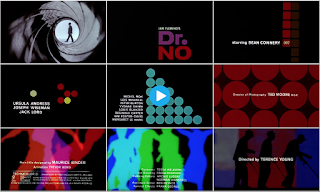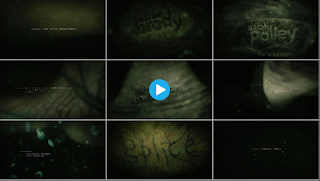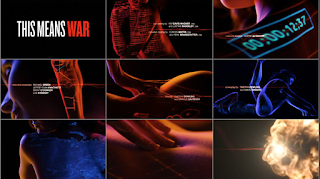Saturday, 27 February 2016
Entry 2:
DESIGNING & FILMING THE WALL:
In our storyboard, we planned to film numerous shots of the antagonist building on his manhunt profile of the protagonist, Agent-X. In preparation for filming this, we started creating and organising the necessary props needed for the shots, for instance, the printed photos of Agent-X's associates, which we used to create the manhunt profile today. After the wall was configured, we then proceeded to filming our needed shots.
Here is evidence of our note board being configured:
Thursday, 25 February 2016
Karin Fong - Title Sequence Designer Research
Karin Fong is a title sequence designer who was conceived and grew up in Los Angeles, she began her career after having attained an art degree. She then joined the west coast studio of R/G/A before becoming a founding member and partner at Imaginary Forces.
Karin has created numerous title sequences for both film and television over the years, her most famous pieces being included in: 'Boardwalk Empire', (2014) 'Terminator: Salvation' , (2009) 'Charlotte's Web', (2006)and 'Rubicon' (2016). Her work has attained her five nominations and also on Emmy for title design. She has also constructed cinematics for the Sony Playstation game, 'God of War III' and large-scale video installations for sites such as Lincoln Centre, Las Vegas, ands the LA Opera.
Karin's work has appeared at the Cooper Hewitt National Design Museum, the Pasadena Museum of California Art, The Wexner Centre, Artists' Space and the Walker Art Centre.
Saul Bass - Title Sequence Designer Research
Saul Bass (1920-1996)
Who was he?
He started his career by designing posters with his ability of being able to capture the mood of a film by using simple images and shapes.
Often, these shapes used were hand drawn by Bass in order to create a more casual appearance. This was also usually accompanied by a sophisticated soundtrack.
Throughout his career he designed over 60 title sequences with his most famous including North by Northwest, Vertigo and Psycho.
He worked alongside Alfred Hitchcock a lot in his career with a good example being Vertigo.
His title sequences revolutionised the style in which we see them these days.
Who was he?
- An American graphic designer who became famous for his work in film.
- He studied design at Art Students League in Manhattan.
- Born in New York on May 8th 1920.
He started his career by designing posters with his ability of being able to capture the mood of a film by using simple images and shapes.
Often, these shapes used were hand drawn by Bass in order to create a more casual appearance. This was also usually accompanied by a sophisticated soundtrack.
Throughout his career he designed over 60 title sequences with his most famous including North by Northwest, Vertigo and Psycho.
He worked alongside Alfred Hitchcock a lot in his career with a good example being Vertigo.
His title sequences revolutionised the style in which we see them these days.
Entry 1:
STORYBOARDING:
During today's media lesson - after having produced our group's audience profile and film pitch - we began the construction of a storyboard for our title sequence assignment. Our storyboard is a basic sequential illustration of what we want/predict to film as footage for our title sequence within the next few days/weeks, essentially an organised plan.
Every member in our group contributed towards the creation of it and we ended up finalising it completely later the same day, again as a full group. We found ourselves particularly discussing how we wanted to employ the micro features - mainly cinematography and mise-en-scene - within our sequence and we ultimately prioritised this the most when creating it. I found myself playing a significant part in the discussion of this due to my broader knowledge of micro features having studied Film Studies at GCSE level, unlike the other members of my group.
Our storyboard shots took heavy inspiration from other relevant film texts within our focused genre, texts such as 'James Bond: Skyfall' (2012) for instance. We took inspiration from how effectively it used settings as iconography to communicate its genre, specifically the establishing-shots of iconic British landmarks within the disruption stage of the film, shots like where the M16 building is seen exploding through pyro-techniques.
Audience Profile
AUDIENCE PROFILE RESEARCH:
This is the audience profile I designed for my group's film production 'AGENT-X' (2016).
I designed this through use of Photoshop CS6 on my PC.
Wednesday, 24 February 2016
Journal
Here I will be recording all contributions me and my group make towards producing our 'AGENT-X' title sequence and how we overcome any issues/obstacles in the process:
Class Notes
TUESDAY 19TH JANUARY:
Genre and how it is defined through N.I.C.S (Narrative, Iconography, Characters and Setting)
ANALYSING GENRE WITHIN TEXTS:
Genre
N.I.C.S- Use to define genre
N- Narrative
I- Iconography (Visual elements which establish the genre)
C- Characters
S- Setting
Analysing genre:
Dr.No
Action/spy film- silhouettes, gun barrel (iconography which establishes the genre). Features Sean Connery-most known for James Bond.

Splice
Sci-fi film, green colour scheme, consistent colour scheme throughout which gives off a skin/ alien effect on the audience.

The back up plan
Chick flick- bright colours. Hybrid: Romantic-Comedy (Rom-Com). Romance iconography- babies on TV. Comedy iconography- Flasher. This film is clearly targeted towards a female audience- elegant typography, animation, colour scheme.

This means war
Rom-Com: references spy film. Uses intertextuality to reference a James Bond film.

Tuesday, 23 February 2016
Title Sequence Research
HISTORY AND PROGRESSION:
Prior to the invention of the cinematograph - a motion picture film camera and projector - in the 1890s, simple title cards were used instead to both begin and conclude silent film presentations to establish to an audience a film's title and the production company(s) involved in the practices of producing and distributing it. In silent cinema, title cards/intertiles were utilised throughout films' narratives to convey dialogue and plot, and it is in some of these early short films that we can see the first initial examples of title sequences themselves, being literally a sequential series of title cards shown at the beginning of a film. With arrival of sound, title sequences became usually accompanied with a musical prelude or overture. Contemporary title sequences have developed this technical convention and now typically establish leitmotif soundtracks within them.
Slowly, as time has progressed, title sequences have evolved and become more elaborate pieces of film within contemporary cinema. Title design saw a pivotal moment of development particularly during the 1950s consequential to the advent of television - which instigated a decline within the film industry - as it forced the 'big six' Hollywood conglomerates (Warner Bro Pictures, 20th Century Fox, Paramount Pictures, Walt Disney Studios, Columbia Pictures and Universal Studios) to all invest in new methods of making cinema more appealing again in attempt to rejuvenate it and recover a diminishing/dwindling audience.
PURPOSE BEHIND TITLE SEQUENCES:
- To commend the primary contributions made in the development process of a film production - conventionally done through editing and applying on-screen text.
- To further endorse actors'/actresses' star power and help develop their filmographies.
- To acquaint audiences instantly with the genre/hybrid-genre of a production - typically through simplistic use of iconography and mise-en-scene.
- To establish the relevant key themes, messages and values of a production's narrative.
- To immediately make attempt at engaging/immersing audience (pre-equilibrium) before the pace of the narrative begins to pick up - commonly done through strongly appealing aesthetics.
'AGENT-X' (2016) Pitch
This is the pitch for our British film production 'AGENT-X' (2016) that I produced for me and my group to present to our media class to promote the necessary funding to create it.
Research and Planning
Our group - after much discussion and dispute both in/out lesson - came to a unanimous agreement of selecting the 'Spy sub-genre' as the context for our title sequence assignment.
RESEARCH INTO THE SPY SUB-GENRE:
Spy genre films generally intertwine narrative elements from both the thriller and action genres - where it derived - and typically deal with the subjects of fictional espionage and organisational conspiracy, either in a realistic way (such as adaptations of John Le Carre) or as a basis for fantasy (the 'James Bond' film franchise: the most internationally respected within the genre. As time has progressed the genre has become a significant aspect of British cinema, with leading directors like Alfred Hitchcock and Carol Reed even making notable contributions with many of their films being set in the British Secret Service.
CODES & CONVENTIONS:
- Espionage.
- Good organisation devoted to stopping the evil one (binary opposition - conformity to Levi-Strauss' narrative theory)
- Exotic and exploratory depictions of culture/settings.
- Suave, sophisticated, well-dressed protagonists.
- A 'temptress' female/'femme fatale' who serves distraction to the protagonist, typically as a sub-plot.
- Possibly Propps' character role of a 'damsel in distress'; not particularly seen within this genre, conventionally more within action/action genre films.
- Manipulative antagonists (typically the heads of illicit organisations) who enact only for personal gain/interests (such as: authority, money or even ownership - connotations attributed to greed).
- Heavy use of gadgets and weaponry.
- Theft of documents/files/formula/technology - something good an antagonist can acquire and use as a force for evil.
- Henchman/personal bodyguards.
- Implausible life or death scenarios the protagonist is pitted against and escapes with ease.
- Realistic military themes.
- Chase sequences (foot and vehicular).
- Fight sequences.
- Pyro-techniques/explosions.
- Aristocratic figures.
Here are some examples of eminent iconography pertaining to the genre:
 Suave, sophisticated dress-senses; generally used to enable protagonists to be distinguishable with ease from other characters. James Bond, (played by Daniel Craig) the eponymous protagonist of the British film franchise - 'James Bond' is an archetype of this. As an audience, we rarely ever see him dressed outside this particular dress-sense, for instance, in more casual wear: his style is not flamboyant, however, it is still iconic of his identity, Instances where we do usually serve particular purpose; the famous 'beach sequence' in his debut installment 'Casino Royale' (2006) for example.
Suave, sophisticated dress-senses; generally used to enable protagonists to be distinguishable with ease from other characters. James Bond, (played by Daniel Craig) the eponymous protagonist of the British film franchise - 'James Bond' is an archetype of this. As an audience, we rarely ever see him dressed outside this particular dress-sense, for instance, in more casual wear: his style is not flamboyant, however, it is still iconic of his identity, Instances where we do usually serve particular purpose; the famous 'beach sequence' in his debut installment 'Casino Royale' (2006) for example.In this sequence he is seen, through use of a tracking/mid-shot, (center frame) slowly emerging from the sea half-naked with his mesomorph figure on full display, purposely enabling female voyeurism.
Resultant of this sequence, discussion arose as to whether a 'female gaze' theory existed too alternatively to Laura Mulvey's already-famous 'male gaze theory'.
Craig's performance in the role also attracted critical acclaim and attained him the '2007 Best Actor' award from Empire Awards for his remarkable debut as the character in 'Casino Royale' (2006). More impressively, his portrayals reignited lost interest in the franchise and brought new from international audiences as well as domestic; Craig himself has become an iconic figurine for the genre.
---------------------------------------------------------------------------------------------------------------------------
(DO A POST WITH 2 TITLE SEQUENCES INTO MY SPECIFIC GENRE):
(DO THE ENTIRE JOURNAL):
OUR EACH INDIVIDUAL ROLE
-LOCATION SCOUTING SHOTS
-SHOTS WE RE-DID AND WHY
-DAYS WE EDITED AND WHAT WE EDITED
-PLACES WE ACTUALLY FILMED AT WHY WE LEFT PLACES OUT
-SOUNDTRACK WE RESEARCHED & WHAT WE ACTUALLY USED IN THE SEQUENCE
-STORYBOARDS AND PROP PLANNING (THE MANHUNT BOARD - PHOTOS OF IT)
-WHAT I LEARNT FROM EVERY STAGE OF IT FOR FUTURE REFERENCE
-------------------------------------------------------------------------------------------------------------------------
Subscribe to:
Posts (Atom)











